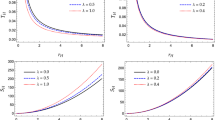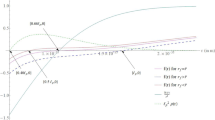Abstract
We study how the entanglement entropy of the Hawking radiation derived using the island recipe for the Reissner–Nordström black hole behaves as the black hole mass decreases. A general answer to the question essentially depends not only on the character of the mass decrease but also on the charge decrease. We assume a specific relation between the charge and mass \(Q^2=GM^2[1-(M/\mu)^{2\nu}]\), which we call the constraint equation. We discuss whether it is possible to have a constraint such that the entanglement entropy does not blow up at the end of evaporation, as happens in the case of thermodynamic entropy and the entanglement entropy for the Schwarzschild black hole. We show that for some special scaling parameters, the entanglement entropy of radiation does not blow up if the mass of the evaporating black hole exceeds the Planck mass.












Similar content being viewed by others
Notes
Formula (2.5) is different from formula (4.17) in [16] and slightly different from formula (24) in [17]. The difference from [17] is due to the different choice of the tortoise coordinate \(r_*(r)\):
$$\begin{aligned} \, &r_{*,[17]}(a)=a+\frac{r_+^2}{r_+-r_-}\log\biggl(\frac{a-r_+}{r_+}\biggr), \\ &r_{*,[17]}(b)=b+\frac{r_+^2}{r_+-r_-}\log\biggl(\frac{b-r_+}{r_+}\biggr) -\frac{r_-^2}{r_+-r_-}\log\biggl(\frac{b-r_-}{r_+}\biggr), \\ &r_{*,\,\mathrm{here}}(r)=r+\frac{r_+^2}{r_+-r_-}\log\biggl(\frac{r-r_+}{r_+}\biggr) -\frac{r_-^2}{r_+-r_-}\log\biggl(\frac{r-r_-}{r_-}\biggr),\quad \text{for }a\text{ and }b. \end{aligned}$$Indeed, at \(\nu\in[1,\mathcal V_1)\) for some \(\mathcal V_1\), as \(\tau\) decreases (if \(b\) increases), the increasing negative third term of the order \(\mathcal O(\alpha^2/\tau)\) can lead to negative derivative (3.5). Similarly, for \(\nu\in(\mathcal V_2,2]\) and some \(\mathcal V_2\), as \(\alpha\) decreases (if \(\mu\) increases) and \(c\) is large enough to exceed the first term, a negative fifth term of the order \(\mathcal O(\tau)\) can lead to negative derivative (3.5).
References
S. W. Hawking, “Particle creation by black holes,” Comm. Math. Phys., 43, 199–220 (1975).
S. W. Hawking, “Breakdown of predictability in gravitational collapse,” Phys. Rev. D, 14, 2460–2473 (1976).
D. N. Page, “Information in black hole radiation,” Phys. Rev. Lett., 71, 3743–3746 (1993); arXiv: hep-th/9306083.
D. N. Page, “Time dependence of Hawking radiation entropy,” J. Cosmol. Astropart. Phys., 2013, 028, 27 pp. (2013); arXiv: 1301.4995.
G. Penington, “Entanglement Wedge Reconstruction and the Information Paradox,” JHEP, 2020, 002, 83 pp. (2020); arXiv: 1905.08255.
A. Almheiri, N. Engelhardt, D. Marolf, and H. Maxfield, “The entropy of bulk quantum fields and the entanglement wedge of an evaporating black hole,” JHEP, 2019, 063, 46 pp. (2019); arXiv: 1905.08762.
A. Almheiri, T. Hartman, J. Maldacena, E. Shaghoulian, and A. Tajdini, “The entropy of Hawking radiation,” Rev. Modern Phys., 93, 035002, 23 pp. (2021); arXiv: 2006.06872.
N. Engelhardt and A. C. Wall, “Quantum extremal surfaces: Holographic entanglement entropy beyond the classical regime,” JHEP, 2015, 073, 27 pp. (2015).
S. Ryu and T. Takayanagi, “Holographic derivation of entanglement entropy from the anti-de Sitter space/ conformal field theory correspondence,” Phys. Rev. Lett., 96, 181602, 4 pp. (2006); arXiv: hep-th/0603001.
V. E. Hubeny, M. Rangamani, and T. Takayanagi, “A covariant holographic entanglement entropy proposal,” JHEP, 2007, 062, 64 pp. (2007); arXiv: 0705.0016.
A. Almheiri, R. Mahajan, and J. E. Santos, “Entanglement islands in higher dimensions,” SciPost Phys., 9, 001, 18 pp. (2020); arXiv: 1911.09666.
C. Krishnan, V. Patil, and J. Pereira, “Page curve and the information paradox in flat space,” arXiv: 2005.02993.
K. Hashimoto, N. Iizuka, and Y. Matsuo, “Islands in Schwarzschild black holes,” JHEP, 2020, 085, 20 pp. (2020); arXiv: 2004.05863.
M. Alishahiha, A. Faraji Astaneh, and A. Naseh, “Island in the presence of higher derivative terms,” JHEP, 2021, 035, 20 pp. (2021); arXiv: 2005.08715.
Y. Matsuo, “Islands and stretched horizon,” JHEP, 2021, 051, 29 pp. (2021); arXiv: 2011.08814.
X. Wang, R. Li, and J. Wang, “Islands and Page curves of Reissner–Nordström black holes,” JHEP, 2021, 103, 19 pp. (2021); arXiv: 2101.06867.
W. Kim and M. Nam, “Entanglement entropy of asymptotically flat non-extremal and extremal black holes with an island,” Eur. Phys. J. C, 81, 869, 10 pp. (2021); arXiv: 2103.16163.
I. Aref’eva and I. Volovich, “A note on islands in Schwarzschild black holes,” arXiv: 2110.04233.
G. W. Gibbons, “Vacuum polarization and the spontaneous loss of charge by black holes,” Comm. Math. Phys., 44, 245–264 (1975).
W. T. Zaumen, “Upper bound on the electric charge of a black hole,” Nature, 247, 530–531 (1974).
B. Carter, “Charge and particle conservation in black-hole decay,” Phys. Rev. Lett., 33, 558–561 (1974).
T. Damour and R. Ruffini, “Quantum electrodynamical effects in Kerr–Newmann geometries,” Phys. Rev. Lett., 35, 463–466 (1975).
D. N. Page, “Particle emission rates from a black hole. II. Massless particles from a rotating hole,” Phys. Rev. D, 14, 3260–3273 (1976).
W. A. Hiscock and L. D. Weems, “Evolution of charged evaporating black holes,” Phys. Rev. D, 41, 1142–1151 (1990).
Cl. Gabriel, “Spontaneous loss of charge of the Reissner–Nordström black hole,” Phys. Rev. D, 63, 024010, 4 pp. (2000).
E. Sorkin and T. Piran, “Formation and evaporation of charged black holes,” Phys. Rev. D, 63, 124024 (2001); arXiv: gr-qc/0103090.
Y. C. Ong, “The attractor of evaporating Reissner–Nordström black holes,” Eur. Phys. J. Plus, 136, 61 (2021); arXiv: 1909.09981.
I. Aref’eva and I. Volovich, “Complete evaporation of black holes and Page curves,” arXiv: 2202.00548.
P. Calabrese and J. Cardy, “Entanglement entropy and conformal field theory,” J. Phys. A, 42, 504005, 36 pp. (2009); arXiv: 0905.4013.
Funding
I. Ya. Aref’eva and I. V. Volovich formulated the problem setup and interpreted the obtained results. The work of I. Ya. Aref’eva and I. V. Volovich was supported by the Russian Science Foundation under grant no. 19-11-00320, https://rscf.ru/en/project/19-11-00320/, and performed at Steklov Mathematical Institute of Russian Academy of Sciences.
Author information
Authors and Affiliations
Corresponding author
Ethics declarations
The authors declare no conflicts of interest.
Additional information
Translated from Teoreticheskaya i Matematicheskaya Fizika, 2022, Vol. 212, pp. 457–477 https://doi.org/10.4213/tmf10273.
Appendix Approximations for entanglement entropy near the extremal regime
We study how closely the extremal case can be approached such that the approximations under which the entropy with an island (2.5) was derived remain valid. Our analysis shows that for fixed parameters \(b\), \(c\), \(G\), \(\mu\), and \(\nu\), there exists \(M_{\mathrm{cr}}(b,c,G,\mu,\nu)\) such that all approximations are valid for \(M>M_{\mathrm{cr}}\).
For this purpose, we sketch the main steps of the derivation of the entropy with an island, Eq. (2.5). From the general formula (2.1), we obtain the entropy with an island for the configuration presented in Fig. 2:
Assuming that \(a=r_++X\), \(X\ll r_+\), we use the approximation
We expand as

To control the degree of smallness of the left-hand sides of (A.7), (A.10), and (A.13) we set
Numerical analysis of the inequalities \(Y_{1,2,3}(\rho)<0\), Eq. (A.16), under constraint equation (1.1) on the \((M,\mu)\) plane for \(\nu=1.5\) and \(\nu=2\), various \(b=10,100,1000\), and \(\rho=5\) is presented in Fig. 13. It can be seen that the condition \(Y_3<0\) is the strongest in most cases, except at relatively small \(b\) and large \(\mu\), as shown in Fig. 13a and Fig. 13d. The larger \(\nu\) and \(\mu\) are, the larger the value of the critical mass \(M_{\mathrm{cr}}\) up to which \(M>M_{\mathrm{cr}}\) the evaporation process can be considered. We also see that there is practically no dependence of \(M_{\mathrm{cr}}\) on \(b\).
Under constraint equation (1.1), the inequality \({\mathbf Y}_3\), Eq. (A.13), can be written as
Summarizing the above consideration, we can say that the approximations that ensure the validity of representation (2.5) for not too small \(b\) simply reduce to one inequality (A.19). Recalling the requirement of closeness to the extremal case, \(\alpha\ll1\), we obtain the inequality
Rights and permissions
About this article
Cite this article
Aref’eva, I.Y., Volovich, I.V. & Rusalev, T.A. Entanglement entropy of a near-extremal black hole. Theor Math Phys 212, 1284–1302 (2022). https://doi.org/10.1134/S0040577922090100
Received:
Revised:
Accepted:
Published:
Issue Date:
DOI: https://doi.org/10.1134/S0040577922090100




